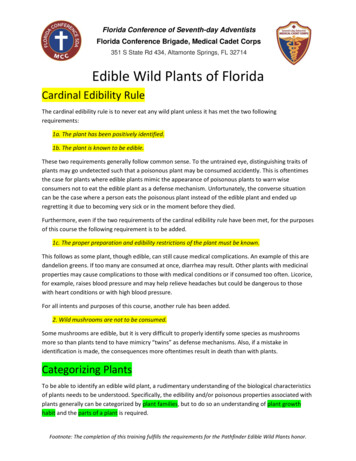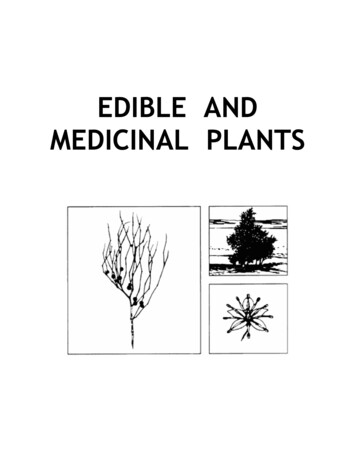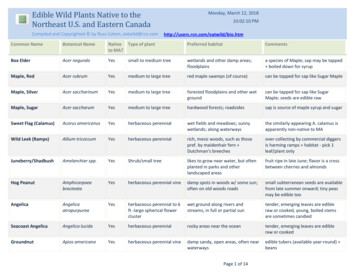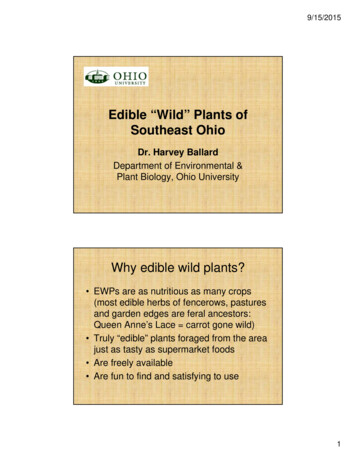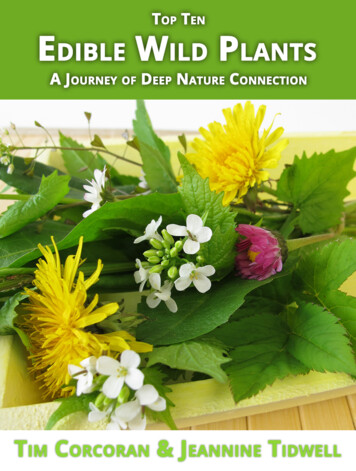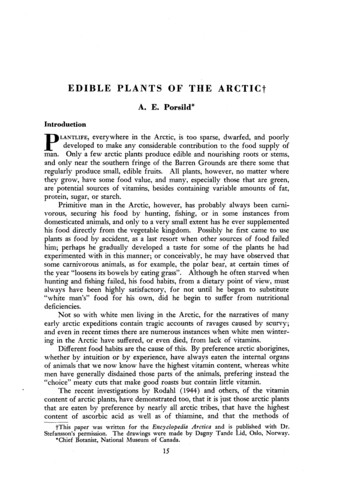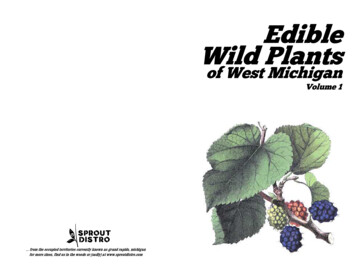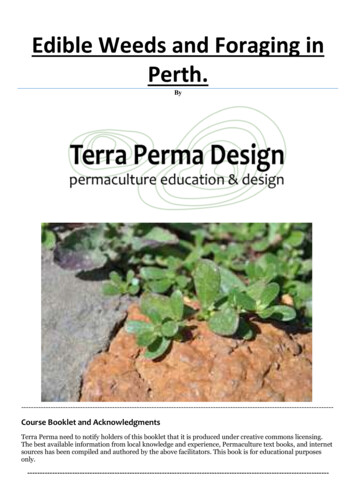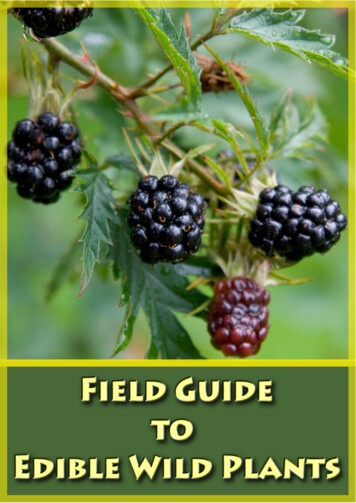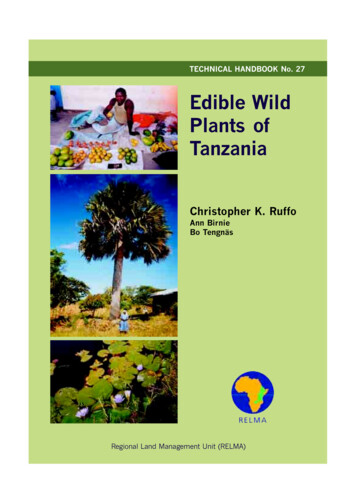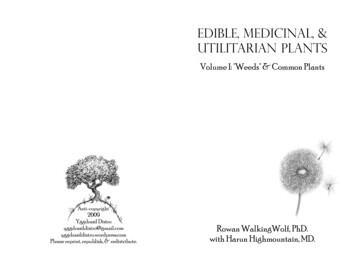
Transcription
Edible, Medicinal, &Utilitarian PlantsVolume I: "Weeds" & Common PlantsAnti-copyright2009Yggdrasil dpress.comPlease reprint, republish, & redistribute.Rowan WalkingWolf, PhD.with Harun Highmountain, MD.
ContentsIntroduction.1Herbs & Shrubs . 3CatnipCattailCleaversCloverComfrey, FoxgloveDandelion, False DandelionFennelGrassLavenderLemon BalmMallowMintMulleinPlantainRaspberry, BlackberryRoseStinging NettleWild Carrot, Poison Hemlock, Water HemlockWood Sorrel, Sheep SorrelYarrowYucca3, 293, 294, 305, 306, 317, 328, 32910, 331112, 3313, 3414, 3415, 3516, 3517, 3618, 3620, 3722, 3823. 3824, 39Trees.26OakPineWillow26, 3927, 3927, 39Plates, Pictures.29Glossary.40Suggested Reading.42
IntroductionPlants are incredible, and plants are everywhere. Even those wholive in the crush and clamor of cities can find a huge variety ofedible, medicinal, and otherwise useful herbs among the plantscommonly called "weeds" by the uninformed. And for those fortunatefolks who inhabit the rural areas of the world, an astonishingdiversity of plant life continues to grow and thrive, despite themassive destruction of plant habitat worldwide.For hundreds of thousands of years, we crafty human beings havebeen using plants with great efficacy to feed and heal ourselves, andto fashion tools in various forms. Despite this, as urban (civilized)humans have become further and further removed from theirlandbases, the knowledge of edible and utilitarian wild plants hasbecome nearly extinct, and the belief that plants are useless asmedicine has become commonplace. Such ignorance- disturbinglyuniversal and constantly perpetuated by Western industry andscience- is unforgivable and easily remedied.With that in mind, this zine is the first in a series of publicationswritten to inspire anarchists and non-radical folks alike to reconnectwith the amazing world of plants. Hopefully, upon reading this andsubsequent works, the reader will never again look down upon thatdandelion breaking through the concrete as a mere weed, or theclover and mallow overtaking grass lawns as nuisances.Before continuing, I should point out the necessity for caution whenharvesting wild plants. Where applicable, I have listed anddescribed potential toxic and deadly lookalikes to the useful plantsbelow. However, although I have many years of the study ofherbalism under my belt, I am by no means a master of the scienceand art of medicinal plants, and there are many plants I don't know.So, if you're ever in doubt as to the nature of a plant's toxicity, err onthe side of caution and don't consume it. Consult at least two1
reputable sources (whatever the fuck that means) before usingunknown plants.As a final note, I must mention the concept of ethical harvesting.Ecosystems the world over are in peril due to the omnipresentdestruction brought about by industrial civilization. Thus, plantlifein its many forms is in a perpetual state of suffering and extinction.Species disappear every day, and it's up to every one of us dissidentsto stop the killing.The point is that when we harvest plants we must do so ethically, toavoid hastening the annihilation of our plant cousins. This entailsdoing and not doing many things. For example, only harvest fromstands where there are multiple plants growing. Harvest deadfalland plant matter already removed from or shed by the plant.Harvest in such a way that the plant is not killed and its growth notimpeded. Only uproot plants when you need the root itself. Neverharvest more than you need. Be conscious of the ecosystem aroundthe plant you're harvesting. Ask the plant (not necessarily withhuman language, but in your heart and mind) if it's okay to harvest it.Smell, touch, examine, and taste the plant before harvesting, get toknow its spirit and its place in its ecosystem, and feel the rightness orwrongness of harvesting it. Vow to the plant (and, really, to all plantand animal life) that by using it you will help ensure its futureexistence (and mean it). Make sure to actually work toward thefuture existence of the plants you use, both by fighting the forceskilling the world and by physically planting and nurturing more ofthose plants. When you physically consume the plant, thank it for itssacrifice and for the healing and nourishment it gives you. Rowan WalkingWolf2
Suggested ReadingPeterson's Fieldguide to Medicinal Plants & Herbs: Eastern/CentralPeterson's Fieldguide to Medicinal Plants & Herbs: WesternThese guides are superb resources for the medicinal herbs of NorthAmerica, although they are very biased toward Westernscience/industry/government. The Western edition is difficult tofind for some reason, even on the website of the publisher.Medicinal Plants of the Pacific West by Michael MooreMichael Moore is a master herbalist, though reading this book, onecan easily confuse him for a comic. His snarky, clever commentarymakes this book a pleasure to read, and the information within isinvaluable for those who wish to learn pacific medicinal herbs.Tom Brown's Guide to Wilderness SurvivalTom Brown's Guide to Living with the EarthTom Brown's Guide to Wild Edible and Medicinal PlantsTom Brown's an ass, plain and simple. Don't buy his books. In fact,don't buy anything. Ever. But do steal them, and study them-theyare treasuries of information on the ways in which plants are usedculinarily, medicinally, and functionally. His Edible and MedicinalHerbs is not my favorite plant book, and it's certainly not the mostcomprehensive, but his writing illustrates the personality of eachplant and provides memorable stories about his interactions withthese plants. This makes remembering what each plant is used for,where they grow, and how and when to harvest them much easierthan reading academic texts like Peterson's.Primitive Toothcare: a DIY Guide to Uncivilized Oral Hygieneby Rowan WalkingWolfThis is another of my zines, available for free on Yggdrasil Distro'swebsite (yggdrasildistro.wordpress.com). Several of the plants listedherein reference this zine and the toothsticks and other primitivemethods of oral hygiene that it explores.42Herbs & ShrubsCatnip, Catmint (Nepeta cataria & spp.) Pg.29Catnip is a common wild and cultivated member of the mint family.Like many members of the mint family, it contains strong calmativeeffects, providing relaxation and soothed nerves when drunk in teaor ingested orally. This lovely herb also aids rough digestion, as doother mints. Catnip is famed for its intoxicating effects on felines(hence the name), but lesser known are its intoxicating effects onhuman beings. Catnip is also an excellent toothache reliever whenchewed and held on painful teeth.I can testify to both catnip's effectiveness as a toothache plant and itsintoxicating principles. Not too long ago, one of my wisdom teeth waspowering its way through my gums and I badly needed relief. Iharvested some catnip from a neighbor's yard, and, over the course ofseveral hours, I ate countless catnip leaves and drank who knowshow many cups of catnip tea. Not only did the pain subside greatly,but I was also overwhelmed by a feeling of general euphoria andgiggly idiocy. It's a lot of fun, and I highly recommend it, especiallyfor those who can share the experience with a feline companion.Cattail (Typha spp.) Pg.29These wetland grasses as among the most easily recognizable, mostwidespread. and most useful plants in all the world. Cattail has beencalled the "supermarket of the swamp" and the "Super Wal-Mart ofthe swamp" by respective redneck sources. The sentiment is trueenough, though equating a plant to a supermarket or to a giant,industrial, community-killing wholesaler utterly disgusts me. Sufficeit to say that cattail is a magical and worthwhile companion.Cattail is identified by its brownish spike raceme, or corndog-liketop thingy. Its other parts resemble large grass.3
Many parts of cattail are edible to humans. The rhizomes, or roots, arestarchy and delicious, nutritious and energy-rich. In late spring, thebases of cattail leaves are young and tender, and can be eaten raw orcooked. In early summer, the developing flower spike can be brokenoff and eaten like corn on the cob. By mid-summer, when the maleflowers are mature, cattail pollen can be gathered and used as aflour supplement or thickening agent.Cattail has a multitude of medicinal uses as well. The root can bepoulticed and used on cuts, wounds, scrapes, burns, stings, andbruises, as well as scabs, inflammations, and smallpox pustules. Theash of burned cattail leaves can be applied to wounds as anantiseptic and styptic.Moreover, as if its edibility and healing properties were not enough,cattail has myriad uses in practicing primitive skills. The straightstalks, when dried, can be used as spindles in starting friction firesand as the shafts of arrows. The downy material of mature cattailheads can be used as tinder, and as insulative lining in moccasins,bedding, diapers, clothing, sleeping bags, and pillows. The leaves canbe woven into everything that requires weaving: clothes, baskets,mats, backrests, chairs, shelters, beds, hats, and so on. Like mullein,the dry seed heads can be dipped in animal fat and burned astorches.Cleavers, Goosegrass, Stickywilly, Stickyweed, Catchweed,Zhu Yang Yang (Galium aparine) Pg.30Cleavers are an aptly named plant, as their tendency to cleave toanything fibrous (including skin) illustrates. Its clingy nature alsoensures that goosegrass travels everywhere humanity does, with theexception of Antarctica. Thus, it is found on every habitablecontinent. Cleavers are an excellent source of vitamin C when eatenor taken in tea form. Eating the plant raw is uncomfortable, as thetoothed leaves tend to cling to the mouth, but it can be boiled tomake it more palatable.4Diaphoretic: substance that promotes sweating.Digestive: something that encourages digestion.Diuretic: increases urination.Emenogogue: substance that promotes menses.Emetic: substance that induces vomiting.Emollient: something that softens and soothes skin.Expectorant: any agent that dissolves thick mucus and is used torelieve respiratory complications. These agents bring up mucus fromthe lungs, bronchi, and trachea.Galactogogue: agent that encourages milk flow in lactating women.Infusion: Tea. Infusions are made by steeping plants in hot (but notboiling) water. Infusions usually involve soft plant matter, likeleaves, flowers, seed pods, and soft stalks.Laxative: a mild purgative.Poultice: Herbs mashed into a soft, paste-like mixture. Usually doneby chewing fresh herbs, or by crushing herbs in a vessel and mixingwith saliva or water. Poultices are applied topically.Purgative: induces watery movement of the bowels, usually withpainful cramps.Sedative: something that induces sedation, or calm, by reducingexcitement and irritability. Opposite of stimulant.Stimulant: a substance that encourages physiological and mentalactivity in the body. Opposite of sedative.Styptic: a substance that checks bleeding from wounds.Tincture: alcoholic extract of plant compounds. This zine is moreconcerned with infusions and decoctions than with tinctures.Tonic: substance that reinvigorates and restores. Also used todescribe plants used to promote general health and well-being.Toothstick: a stick chewed and brushed with to encourage oralhealth. Please see Primitive Toothcare: a DIY Guide to OralHygiene available for free on the Yggdrasil Distro website.Vermifuge: agent that expels parasitic worms from the body.Vulnerary: substance that heals wounds; a curative.Wash: using an infusion/decoction topically. Also, something wecrusties don't do very often.41
GlossaryI've done my best in the previous pages to use the simplest languagepossible, not only to help novice herbalists understand the nature ofthese plants but also because I hate overly verbose medical jargon.However, I've probably used a few big medical words herein. Plus,many other herbal medicine texts and teachers use terms thatbeginners may not understand. For all these reasons, here is a simpleglossary of terms:Abortifacient, Abortive: a substance that induces abortion throughone of several means.Analgesic: a pain killer.Anti-inflammatory: a substance that reduces inflammation, thusrelieving pain.Anti-bacterial: helps prevent bacterial infection.Anti-fungal: helps prevent infection/infestation of fungusesAnti-septic: an anti-bacterial substance applied to living tissue thatreduces the chance of sepsis or putrefaction.Anti-spasmodic, Spasmolytic: suppresses spasms or musclecontractions.Anti-tussive: prevents coughing.Astringent: a substance that shrinks or constricts body tissue.Calmative: a mild sedative; agent that calms.Caminative: a substance that prevents internal gas formation or aidsin the expulsion of said gas.Decoction: the boiling of woody plant matter- that is, roots, bark, andstems- to extract beneficial compounds. Decoctions differ frominfusions in that they involve hard plant matter that is boiled, ratherthan soft plant matter that is steeped in hot (non-boiling) water.Decocting herbs usually takes between 5-30 minutes, depending onthe desired potency and the plant matter itself.Cathartic: a powerful purgative, causing severe anal explosion, withor without pain.Demulcent: agent that soothes irritated mucous membranes.40In terms of medicine, the plant is used to treat liver and bladderproblems, ulcers, urinary problems, tonsillitis, hepatitis, and cystitis.The plant has a mild laxative effect, it stimulates the lymphaticsystem, it is used as a general detoxifier in treating cancer, and thefresh plant and juice can be used to treat wounds and a multitude ofskin problems, like psoriasis and eczema.The dried seeds of the plant can be ground into an excellent coffeesubstitute, and a decoction of the root produces a red dye. When leftalone cleavers often grow into huge tangled thickets. Such thickets,when harvested, make excellent insulation for primitive shelters, asthey cling together and to other materials, and can be stuffed intosmall spaces in great density.Clover (Trifolium spp.)Pg.30Clover is a delightful little plant, often considered a weed andfrequently overlooked as an edible and medicinal plant. First andforemost, the plant's beautiful flowers are edible and delicious. Withover 300 species worldwide, there are quite a few shapes, sizes, andcolors of clover flower to choose from. The leaves of clover are alsoedible, in raw form when young, and boiled or steamed for 5-10minutes when older. The entire plant is high in protein and othernutrients.All species are important to wildlife and insects, and clover is alsoecologically crucial because it fixes nitrogen in the soil andcontributes to a healthy nitrogen cycle, which, in turn, leads tohealthier ecosystems and plants in general. In this capacity, it is oftused as a ground cover with other food crops that thrive on its abilityto fix nitrogen.Clover is used medicinally to treat skin problems like eczema andpsoriasis. It is particularly good for treating children's skin ailments,but has some degree of effectivity in treating adults. Clover infusionsare good at treating coughs and bronchitis, and especially in5
remedying whooping cough. Taken internally, clover purifies theblood, and helps combat cancerous growths of the stomach andelsewhere.Comfrey (Symphytum officinale & spp.)Foxglove (Digitalis purpurea)YuccaOakPg.31Pg.31Comfrey, while a wondrous plant, is perhaps best not at healing butat illustrating the fallacy and intentional harmfulness of industrial"science." The Food and Drug Administration here in the U.S. bannedthe use of comfrey in commercial pharmaceuticals a couple yearsago after concluding it is unsafe for human consumption. Thisfarcical analysis is based on a study in which the alkaloids found inthe plant were extracted, concentrated in huge amounts, andinjected into rats who then died of liver failure. This is farce firstbecause rats are not humans, and therefore rat testing does notreflect human consumption of a given substance. It is also amisleading conclusion because the alkaloids found in any plant(carrots, tomatoes, coffee, or potatoes, for example) will cause liverfailure in mammals when heavily concentrated.* Acorns!* Distinctive leavesPineWillowMy point in mentioning all this is that comfrey has an undeservednegative reputation based on some very shaky research. In the realmof non-industrial, non-Western science, however, comfrey has beenused for its astonishing healing powers for thousands and thousandsof years by human beings without adverse effects. The root tea andless-potent leaf tea are used as a general tonic, and to treat diarrhea,dysentery, bronchial irritation, coughing, vomiting of blood, and"female maladies." The leaves and root can be poulticed to healfractured and broken bones, to promote the healing of wounds,bruises, and ulcers, and to help relieve sore breasts. Root tea and leaftea can also be used with great potency to heal fractured and brokenbones.Warning: some people (I don't really known any, but several goodsources say this is true) apparently confuse comfrey for foxglove639
Wood SorrelSheep Sorrel(digitalis purpurea). Whereas the toxicity of comfrey is largelyrumor, foxglove will, indeed, kill the shit out of an adult humanbeing. Foxglove has much larger, showier pink and/or white flowersand tends to grow in straight, upright stalks. Comfrey, on the otherhand, tends to grow in dangling bunches of small pink or whiteflowers on bent stalks, and usually has larger leaves than foxglove.Make sure to properly identify comfrey before consuming.Dandelion (Taraxacum officinale & spp.)False Dandelion, Catsears (Hypochaeris radicata)Pg.32Pg.32To be candid, every time I hear someone scornfully talk down themagnificent dandelion as a weed or pest, I want to punch that person.A lot. Taraxacum officinale and the related T. erythrospermum arefound worldwide, making dandelion an important plant for noviceand expert herbalists alike.YarrowEvery part of the dandelion plant is edible. The leaves, while bitterwhen eaten raw, can be boiled for 5-10 minutes to increase edibility.The roots can be chewed, eaten raw by the adventurous, and cookedas a woody root vegetable. The flowerheads are edible raw, makingthem an excellent spring snack or a brilliant addition to a wild salad.The leaves and flowers are abundant in vitamins A and C.Dandelion's importance as a medicinal herb should not be underappreciated. The fresh root taken in tea form helps detoxify andpurify the liver, kidneys, gall bladder, and bladder, and helps to fixailments with these organs. Root tea also promotes bile flow andweight loss. The dried root, though perhaps slightly weaker, has thesame effects. Dried dandelion root can also be ground and used as adelicious coffee substitute.38Dandelion has the same effects on the soil in which it grows as it doeson the liver and kidneys. It purifies soil, sucking up toxins andemanating positive compounds. So, when harvesting dandelion,7
make sure the soil you're plucking it out of isn't contaminated withlots of toxic nastiness. This is especially important for those dwellingin cities, where dandelions are generally most toxified. Thedetoxifying nature of dandelions, coupled with their universalityand ease of growth, makes these plants very beneficial inpermaculture initiatives.Pretty much everywhere dandelion occurs, a remarkably similarplant known as cat's ear, catsear, or false dandelion ( Hypochaerisradicata) also thrives. Catsear has somewhat darker, glossier,rounder, hairier leaves (i.e.- more like a cat's ear), and the leaves tendto grow in basal rosettes close to the ground. Catsear has long, thin,solid, forked stalks with several flowers to a single plant, whereasdandelion's stalk is singular and hollow. All parts of catsear areedible, and the dried root can be used as a coffee substitute likedandelion.Wild Carrot, Queen Anne's LacePoison Hemlock* "Bird's nest"* Hairy stems* Purple/red flower inmiddle of flowerhead* Green stemsWater HemlockFennel (Foeniculum vulgare) Pg.32Fennel grows like fire spreads in a dry pine forest. That is to say,really freakin' fast. It is a tall green plant in the umbelliferae family,and looks like many other umbelliferous plants. Fennel hasdistinctive yellow flowers and lacy, feathery leaves. It can growquite tall and wide. Fennel is closely related to dill.Fennel is entirely edible and is revered throughout the Indiansubcontinent, the Middle East, and Italy for its flavor and desirabilityin cooking. Every part of the plant, when chewed, tastes like anise orlicorice. Some love this taste, others despise it, and it seems very fewpeople are indifferent to fennel's powerful taste and aroma. Theflowers, leaves, and bulbs can be prepared in just about any way andin any dish, but they can also all be eaten raw.Fennel is used medicinally in a number of different ways. The seedscan be eaten and all parts of the plant can be made into tea torelieve excessive gas and to promote milk flow in new mothers.8* Purple spots on stems* Leaves stink when crushed* No bird's nest* Smooth stems* Grows near water* Plant stinks* No bird's nest* Smooth stems37
Babies stricken with colic and/or vast fartiness can be treated withfennel. Fennel tea has a great calmative effect on upset stomachs andintestines, and aids tremendously in difficult digestion. Some peoplesuggest consuming fennel improves eyesight. Fennel tea can beapplied directly to the eyes as eyedrops or as a compress, whichreduces inflammation and soreness in the eyes.RoseBesides these uses, fennel plays a crucial role in primitive tooth careand general DIY oral hygiene. The seeds can be chewed toencourage fresh breath, healing of connective tissue (gums), and toassist in cleaning the teeth. All parts of the plant can be consumed topromote oral health and to combat halitosis. The semi-woody stalksof older fennel plants can be used as flimsy toothsticks. For more onprimitive toothcare and how fennel plays into it, please see my zinePrimitive Toothcare: a DIY Guide to Uncivilized Oral Hygiene , alsoavailable for free from Yggdrasil Distro.Stinging NettlesAs a note of warning: many members of the umbelliferae family lookalike, and some of them are deadly. Please don't confuse fennel forpoison hemlock (conium). This plant has yellow flowers, while poisonhemlock's flower are white. For a description of poison hemlock, seethe section on Queen Anne's Lace/Wild Carrot.Grass(not pictured)Grass is everywhere, and is easily identified. Grass is often ugly,invasive, destructive to native ecosystems where it doesn't belong,and prolific in spreading and choking out native plants. However,even with its expansive and destructive tendencies, this universalplant has its uses.36Most species of grass are edible to human beings. Grass certainly isn'tthe tastiest of wild foods, but it's enough to provide nutrients andkeep one alive in survival situations. After removing the tough,fibrous coating, grass seeds are easily eaten and digested. Grassblades/leaves are also edible, though they tend to cause indigestion9
and stomach turmoil if consumed in great quantity.Narrowleaf PlantainBroadleaf PlantainAlthough it has use as food, grass is arguably most useful because ofits utility in building shelters and making tools. Bundles of driedgrass straw are used in making thatched dwellings and, really,anything else that requires thatching. Hats and clothes can be madeof dry grass straw, and clothes and other objects of warmth that arealready functional can be stuffed with dry grass for better insulation.Dry grass makes passable tinder and kindling, and is good beddingfor primitive shelters. Grass can be coiled and sewn (using grassthread) into coiled grass baskets, which, if done with great care, canmake watertight bowls and cookware. Long strands of slightlytwisted grass make the poorest quality useable cordage, and strips ofgrass can be used as a very low quality sewing thread. Sewing withgrass blades is used primarily to keep things to bound together untila better thread can be made or found.Lavender (Lavandula spp.) Pg.33I can't praise this plant enough. It is gorgeous in all its forms; itsfragrance has no comparison. Lavender is native to theMediterranean, northern Africa, and India, although its desirablequalities cause humans to cultivated around the world. Lavenderoften escapes cultivation and rewilds itself in a number of climatesand bioregions, and it can be found in just about every part of theworld, making it a worthwhile plant for beginning herbalists tostudy. The plant is easily recognizable in its varied forms, some ofwhich flower lavender and dark purple in color, and others of whichare white or pinkish.Lavender is a soothing plant, plain and simple. It's scent alone isenough to quiet shattered nerves and mental unrest, althoughinfusing the flowers, leaves, and stalks makes a potent calmative tea.A word of caution: too much lavender will knock you out. Drinkingtoo much lavender tea too early in the day makes for drowsiness andlack of focus, due to the plant's strength in relaxing. For this reason,10BlackberryRaspberry35
lavender can be used as a sleep aid, best taken shortly before tryingto sleep.MintsLavender also comes in handy for relaxing tense or bruised muscles.The essential oil, rubbed on topically, works best in this regard, but atopical wash of lavender infusion works nicely too. Essential oil orinfusion rubbed onto the temples greatly relieves headaches andmigraines. Because of its anti-inflammatory principles, lavender canalso be used to lessen the pain and swelling of insect bites, and it canbe applied to acne and burns to induce healing.Lavender stems are strong and somewhat pliable, and in a pinch canbe used as makeshift cordage to bind things together.Lemon Balm, Melissa (Melissa officinalis)Mullein(see Mint Pg.34)This member of the mint family takes its name from the Greek for"honey bee," because it attracts and nourishes these creatures. Lemonbalm has properties similar to all other mints, and has the squarestem indicative of the mint family. Its appearance is overall quitesimilar to the domestic and wild mints, though it can bedistinguished and identified by its roundish toothed leaves andoverpowering lemon scent. Even a casual rubbing of the leaves orstalk produces the characteristic lemon smell that gives this plant itscommon name. Melissa grows everywhere, especially as an invasiveweed in North America.Lemon balm, like other mints, is a strong calmative. An infusion ofthe leaves, flowers, and stalks brings about a sense of relaxation andis a tried and true reliever of stress. Dried or fresh leaf tea has alsobeen used as a folk remedy for fevers, painful menstruation,headaches, colds, insomnia. As with other mints, lemon balm can betaken internally to treat headaches and fevers, but is also effective asan external wash on the affected regions.3411
Perhaps most interestingly, melissa fiercely combats the Herpessimplex. I have oral herpes myself, and can attest to this plant'sefficacy in beating back cold sores and lessening their pain whenpresent. To treat herpes, use a poultice of the fresh plant or applyinfusion topically and internally. This remedy also holds true forother viruses, like Newcastle disease and mumps. Lemon balm is alsoa general antibacterial and antiviral agent.LavenderMallow, Marshmallow, Cheeses, CheeseweedPg.33(Malva neglecta, M. sylvestris, other Malva spp.)To some extent, all of the plants in this volume grow everywhere. Butmallow seriously grows everywhere. The two most widelydistributed species are M. neglecta and M. sylvestris, both of whomare known by a variety of names involving the word mallow, andboth of whom are native to Europe, Africa, and Asia. There arecountless other species of mallow almost as widespread and invasiveas these two. All mallow species are characterized by their hairy,wavy, distinctive leaves, pink or white 5-petaled flowers, andcheese-like fruits that give them the names "cheeses" and"cheeseweed." Several species of mallow, particularly those whogrow in marshes, are called "marshmallow," and, indeed, this plant iswhere the sugary monstrosity known as marshmallow originates.MallowThis plant is often a destructive weed, but, fortunately for humanityand the planet, it is edible, delicious, and has medicinal andfunctional uses. The entire plant can be eaten raw or cooked. Theroots, when chewed and eaten, become silky and sweet and taste ofmarshmallows. Because of the healing compounds and mucilagecontained within the root, and because its soft nature makes it apleasure to chew, mallow taproots make superb toothsticks. Theleaves and seedpods are also edible, and highly nutritive. I atemallow seeds for the first time while writing this today, discoveringhow choice and nutrient rich they are for myself. I recommend themhighly.1233
DandelionFalse DandelionThe mucilaginous nature of mallow makes it an excellent soupthickener, throat coater, irritated mucous membrane soother, anddigestive system aid. Leaf and root tea can be used internally forcoughs, bronchitis, and stomachaches, and makes a good generalmouthwash. The leaves can be poulticed on wounds and tumors topromote healing.Mint (M
Tom Brown's Guide to Wild Edible and Medicinal Plants Tom Brown's an ass, plain and simple. Don't buy his books. In fact, don't buy anything. Ever. But do steal them, and study them-they are treasuries of information on the ways in which plants are used culinarily, medicinally, an
